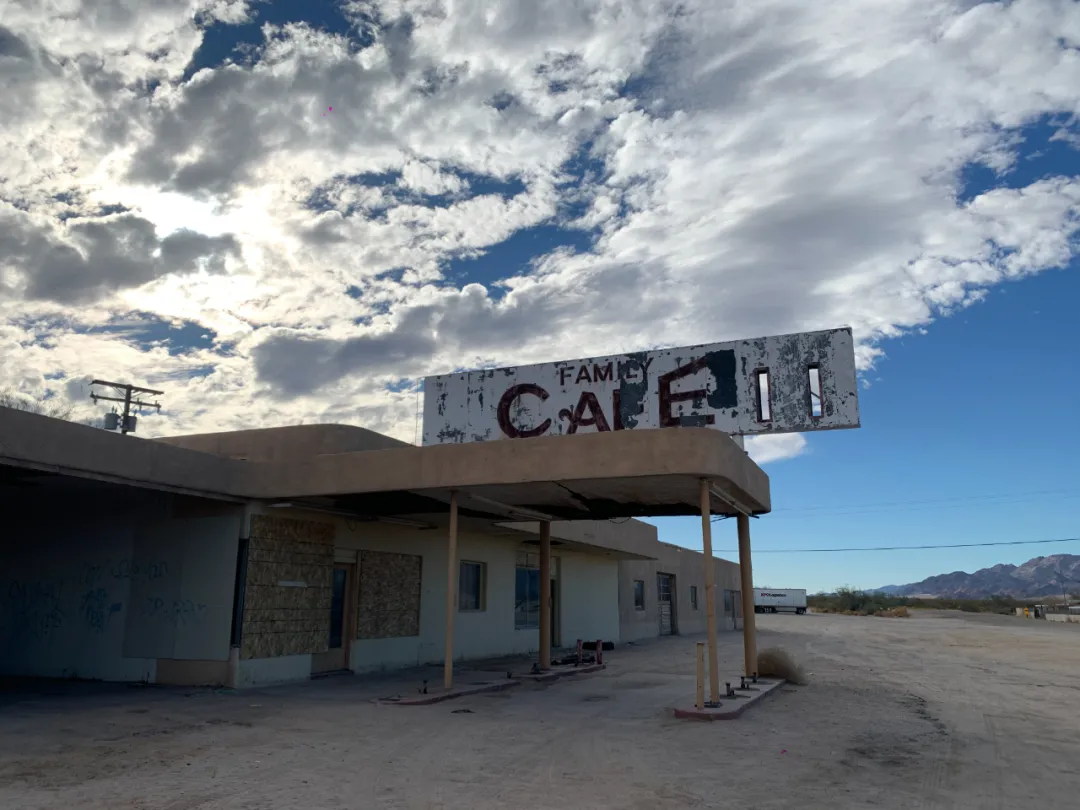
If you drive east along the I-10 freeway from Los Angeles, you’ll transition from the coastal scenery of the Pacific to the vast desert landscape, eventually reaching Phoenix, Arizona. At the midpoint between Los Angeles and Phoenix lies a long-abandoned desert “ghost town”—Desert Center. Established in 1921 by Stephen Ragsdale, this small desert town was, for a long time, the only place within an 80-kilometer radius where travelers could find food. When the town’s only restaurant officially closed in 2012, Desert Center was left completely deserted.
I had only one brief encounter with Desert Center. A few days ago, on my way back from a trip to Lake Havasu City, Arizona, I had planned to stop there for lunch, only to find that all commercial establishments had long been abandoned. This included a restaurant called Historic Desert Center Café, a small grocery store, and what used to be a 24-hour repair shop. The only exception was a small USPS post office, which, to this day, still serves passing travelers and the few remaining locals.
At its peak, Desert Center had a population of several hundred. The residents lived in shacks and trailers, providing services for nearby Eagle Mountain, a mining town. Children from both towns attended a small school here. At one time, the town even had an outdoor swimming pool, where people could escape the relentless California sun for just 10 cents. Stephen Ragsdale was known for his creative advertising slogans to promote the town, such as:
- “We are open 24/7 because we can’t find the key to lock up.”
- “If the sun doesn’t shine in Desert Center, you’ll get free room and board.”
- “Go to hell, or visit me in Desert Center in August” (referring to the unbearable desert heat).
After Stephen Ragsdale passed away in 1971, his son, Stanley Ragsdale, continued running businesses in Desert Center, adding a burger joint and a gas station. In 1990, Stanley even planted some palm trees, but since his death in 1999, they have not been maintained and are now in poor condition. Like more than 370 other ghost towns in California, Desert Center met its fate when the nearby Eagle Mountain mine shut down. With no jobs and no reason to stay, residents gradually left. Today, all that remains of Desert Center are empty buildings, fading memories, and the eerie silence of the night.
Not every ghost town becomes a tourist attraction—most are simply places where ordinary people once lived. Desert Center has no dramatic stories, only the memories of the hundreds who once called it home. And even those memories are fading, as the Ragsdale family passes on, the last residents move away, and the buildings crumble into dust.
But has Desert Center truly ceased to exist? I don’t think so. As long as future travelers continue to explore and tell its story, it will never be completely forgotten.
I hope that one day, Desert Center can be revived. From a commercial perspective, the town has great potential—its facilities could once again serve travelers along the I-10 freeway. The old restaurant or repair shop could be converted into a museum, preserving the history of desert settlements. But perhaps that is just a fantasy. Everything on this barren land is slowly vanishing—every cup, every piece of furniture, every sign that once stood here.
I guess, in the end, the Ragsdale family finally found the key to lock the door.
